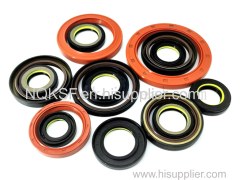
Hot Sell Different Types Oil Seal Nbr Fkm Auto Double Lip Oil Seal
| Min. Order: | 500 Piece/Pieces |
|---|---|
| Trade Term: | EXW |
| Payment Terms: | L/C, D/P, D/A, T/T, WU |
| Supply Ability: | 10000000 |
| Place of Origin: | Hebei |
Company Profile
| Location: | Xingtai, Hebei, China (Mainland) |
|---|---|
| Business Type: | Manufacturer |
Product Detail
| Means of Transport: | Ocean, Air, Land |
|---|---|
| Standard or Nonstandard: | Standard |
| Style: | Others |
| Material: | Rubber |
| Brand Name: | nqksf |
| Application: | Industrial bearing, Pump Hydraulic Machine Rotary Shaft |
| Feature: | Oil/ Heat/ High Pressure Resistance, Durable |
| MOQ: | 10 PCS |
| Production Capacity: | 10000000 |
| Packing: | 10 pcs/ 1 paper scroll |
| Delivery Date: | 7-15 |
Product Description
Oil seals are an essential component in various industrial and mechanical settings, preventing the leakage of fluids such as oil and lubricants. When selecting oil seals, several factors need to be taken into account to ensure optimal performance and longevity. Let's delve into the different dimensions involved in the selection process.
Material Selection
The choice of material is crucial when selecting oil seals. Common options include nitrile rubber, polyacrylate, silicone, fluorocarbon, and polytetrafluoroethylene (PTFE). Each material offers distinct properties such as temperature resistance, chemical compatibility, and flexibility. Nitrile rubber, for instance, is ideal for standard applications, while PTFE exhibits excellent resistance to aggressive chemicals and extreme temperatures.
Application Environment
Understanding the operating environment is imperative. Factors such as temperature variations, exposure to chemicals, and pressure levels significantly impact the performance of oil seals. High-temperature environments may necessitate the use of seals with heat-resistant materials, while exposure to corrosive substances might call for chemically resistant seals. Tailoring the selection to the specific application environment ensures optimal functionality.
Design Considerations
Oil seals come in various designs, each suitable for different applications. Options include single-lip, double-lip, and triple-lip seals, as well as variations in spring-loaded seals. These designs have specific functionalities, such as preventing contaminants from entering the system, retaining lubricants, and handling radial or axial movements. Understanding the design implications in the given system is vital for selecting the most appropriate oil seal type.
Seal Performance Requirements
Consideration of performance requirements is essential. Factors such as speed, pressure differentials, and expected service life influence the choice of oil seals. High-speed applications may require seals designed to withstand greater frictional forces, while high-pressure differentials call for seals with robust sealing capabilities. Evaluating these performance criteria ensures the selected seals can meet the demands of the application effectively.
Cost and Longevity
Balancing cost and longevity is crucial in the selection process. While high-performance materials and designs may offer superior functionality, they often come at a higher cost. Nevertheless, investing in durable seals can result in longer service intervals and reduced maintenance, ultimately saving costs in the long run. Thus, weighing the initial investment against long-term benefits is vital for making an informed decision.
In conclusion, the selection of oil seals involves a careful assessment of material compatibility, environmental factors, design suitability, performance requirements, and cost considerations. By considering these aspects comprehensively, engineers and maintenance professionals can choose the most appropriate oil seals for their unique applications, ensuring reliable performance and longevity.

